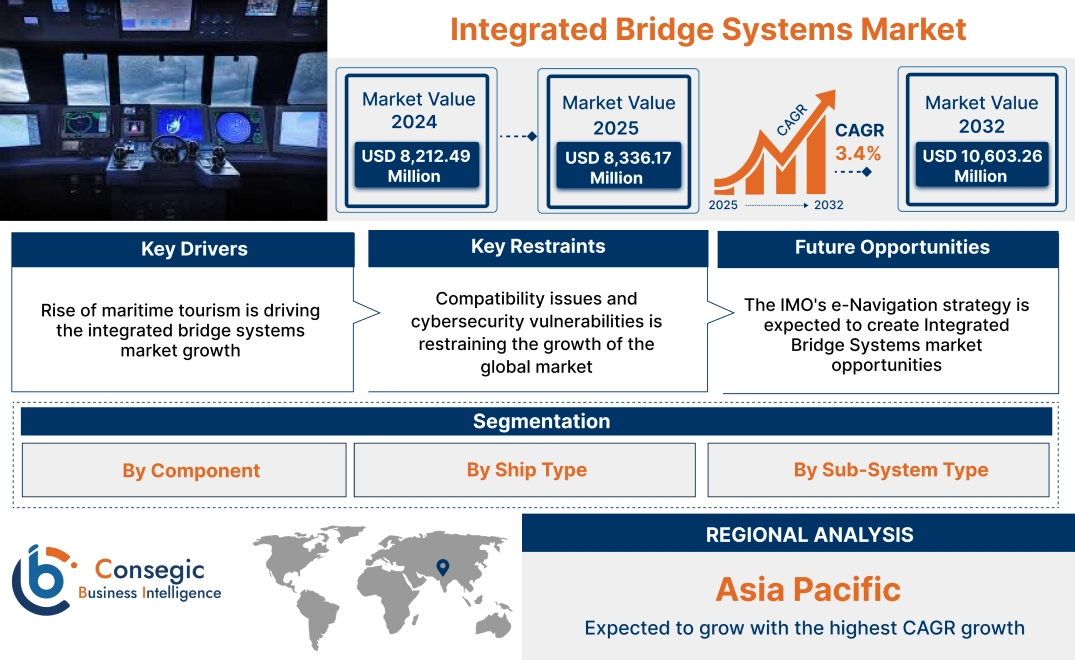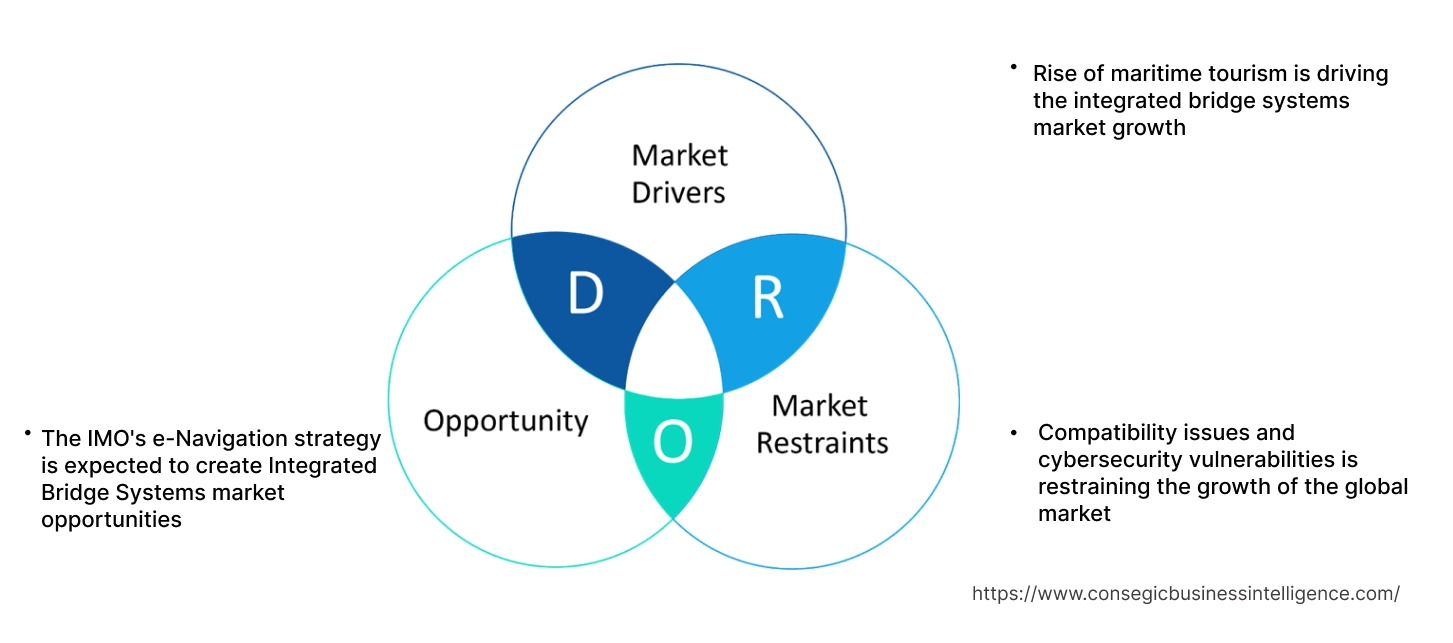- Summary
- Table Of Content
- Methodology
Integrated Bridge Systems Market Size:
Integrated Bridge Systems Market Size is estimated to reach over USD 10,603.26 Million by 2032 from a value of USD 8,212.49 Million in 2024 and is projected to grow by USD 8,336.17 Million in 2025, growing at a CAGR of 3.4% from 2025 to 2032.
Integrated Bridge Systems Market Scope & Overview:
An integrated bridge system (IBS) is a combination of interconnected systems on a ship that allows centralized access to sensor information and control from workstations. This integration aims to enhance safe and efficient ship management by qualified personnel. These systems include navigation, communication, machinery control, and security systems, providing a comprehensive overview of ship operations in one location.
Key Drivers:
Rise of maritime tourism is driving the integrated bridge systems market growth
Passenger safety is paramount on cruise ships and ferries, and IBS enhances this by providing advanced navigation and communication systems, collision avoidance technologies, and real-time monitoring capabilities. Additionally, these systems optimize operations by facilitating efficient route planning and fuel management, leading to cost reductions and improved efficiency. Moreover, compliance with stringent safety and environmental regulations within the maritime tourism industry is facilitated by IBS features such as ECDIS, VDR, and emission monitoring systems.
- For instance, according to Ocean Panel, Coastal and marine tourism is a foundation of the global tourism industry, constituting approximately 50% of all global tourism activity and generating USD 4.6 trillion, equivalent to 5.2% of global GDP. This sector is poised to become the largest within the ocean economy by 2030, projected to employ approximately 8.5 million people worldwide.
- Thus, as per the analysis, the expansion in the maritime tourism is driving the integrated bridge systems market share.
Key Restraints:
Compatibility issues and cybersecurity vulnerabilities is restraining the growth of the global market
IBS involves components from various manufacturers (radar, sonar, navigation systems, etc.) and these components use different communication protocols, data formats, and software interfaces. The lack of standardization makes integration time-consuming and potentially error prone. Additionally, modern systems are increasingly interconnected, with networks linking various onboard systems and potentially external communication channels, creating more entry points for cyberattacks. Moreover, these systems control vital ship functions like navigation and propulsion and a successful cyberattack could compromise safety and cause significant financial losses, further hindering the global integrated bridge systems market expansion.
Thus, as per the integrated bridge systems market analysis, compatibility issues and cyberattacks are impeding the integrated bridge systems market growth.
Future Opportunities :
The IMO's e-Navigation strategy is expected to create Integrated Bridge Systems market opportunities
e-Navigation emphasizes the seamless exchange and integration of data from various sources, including shipboard sensors, shore-based systems, and external sources like weather and traffic information. IBS are crucial for collecting, processing, and displaying this data in a user-friendly format, enhancing situational awareness. Additionally, the IMO's push for digitalization necessitates the adoption of advanced technologies like Electronic Chart Display and Information Systems (ECDIS), Automatic Identification Systems (AIS), and Voyage Data Recorders (VDRs). IBS act as the central hub for integrating these systems and ensuring their interoperability.
- For instance, the e-navigation Strategic Implementation Plan (SIP) aims to revolutionize maritime navigation by implementing five key solutions. These include modernizing bridge design for user-friendliness, establishing standardized automated reporting systems, enhancing the reliability and integrity of onboard equipment and navigational data, integrating and visually presenting information received through communication devices, and improving the dissemination of Vessel Traffic Services (VTS) information beyond just VTS stations. These measures collectively aim to enhance safety and environmental protection within the maritime domain.
- Hence, based on the analysis the IMO's e-Navigation strategy presents significant integrated bridge systems market opportunities.
Integrated Bridge Systems Market Segmental Analysis :
By Component:
Based on the component, the market is bifurcated into Hardware and Software.
Trends in the Component:
- The growing trend towards autonomous and remotely operated vessels necessitates advanced software for navigation and control.
- Advanced systems increasingly rely on sophisticated software for tasks like route planning, collision avoidance, and communication with shore-based facilities.
The hardware segment accounted for the largest revenue share in 2024
- Integration of new sensor types, such as LiDAR, radar, and computer vision systems provides more comprehensive situational awareness and improves navigation capabilities.
- Hardware-based security measures, including secure boot mechanisms and tamper-proof hardware are important to protect against cyber threats, hence propelling the integrated bridge systems market demand.
- The demand for smaller, lighter, and more energy-efficient hardware components is driving innovation in areas like display technology, radar systems, and communication equipment.
- For instance, Elesia’s 55" display allows full HD resolution with Enhanced Visualization Technology and is world’s first 55” MIL qualified LSD with carbon fiber chassis for a low total weight. The high-resolution touchscreen enables intuitive interaction and streamlines workflows, while its ruggedized design ensures durability in harsh marine environments.
- Thus, as per the analysis, the aforementioned factors are driving the hardware integrated bridge systems market size.
The software segment is expected to register the highest CAGR over the forecast period
- Software plays a crucial role in analyzing data from various sensors and systems to optimize vessel performance, predict maintenance needs, and improve fuel efficiency.
- Software-defined systems enable more flexible and modular designs, allowing for customization based on specific operational requirements.
- Additionally, the emergence of advanced software with improved user interface and touchscreen controls is also driving the integrated bridge systems market trend.
- For instance, Kongsberg Maritime’s K-Master Solutions seamlessly manages and monitor complex vessel operations with intuitive interfaces and integrated controls. The solution enables real-time data integration and analytics for enhanced decision-making and operational efficiency.
- Therefore, as per analysis, the aforementioned integrated bridge systems market trends are expected to continue driving expansion in the software market size in the coming years.
By Ship Head:
Based on the ship head, the market is segmented into commercial ships and defense ships.
Trends in the Ship Head:
- Commercial shipping is focused on reducing environmental impact and IBS is playing a crucial role in optimizing fuel consumption, reducing emissions, and improving vessel efficiency.
- Defense ships require advanced capabilities for detecting and tracking threats, both above and below the surface. These systems incorporates sophisticated sensors, radar systems, and communication technologies to provide comprehensive situational awareness.
The commercial ships segment accounted for the largest revenue share in 2024 and is also projected to witness the fastest CAGR
- Integrated bridge systems optimize loading and unloading operations in bulk carriers by integrating with cargo handling systems, providing real-time data on cargo levels and stability.
- Monitor cargo temperature, pressure, and other parameters to ensure cargo integrity and prevent spills or explosions, which in turn is driving the market trend.
- Enhance passenger safety in cruise ships through advanced collision avoidance systems, fire detection, and emergency communication systems. These systems also provides entertainment and information systems for passengers, such as interactive maps and real-time updates on ship activities.
- For instance, according to CLIA (Cruise Line International Association), cruise industry has recovered strongly, exceeding 10 million passengers since resuming operations in July 2020. With nearly 100% of the fleet back in service and passenger interest mirroring pre-pandemic levels, the industry has proven its ability to navigate challenges.
- Overall, the increasing adoption of integrated bridge systems in commercial ships including bulk carriers, cruises and tankers are driving the integrated bridge systems market size.
By Sub-system Type:
Based on the sub-system type, the market is segmented into INS, automatic weather observation system, voyage data recorder, and automatic identification system.
Trends in the Sub-system Type:
- Transition from traditional mechanical gyroscopes to fiber-optic gyroscopes (FOG) and ring laser gyroscopes (RLG) to offer improved accuracy.
- Integration of advanced sensors like Doppler radar, lidar, and ceilometers for more comprehensive and accurate weather data.
INS accounted for the largest revenue share of 38.98% in the year 2024 and is also projected to witness the fastest growth
- Modern INS systems are increasingly integrated with other navigation systems like GPS, GNSS, and radar, enabling data fusion algorithms to enhance accuracy and provide more robust position and heading information.
- By providing reliable position and heading information, INS plays a crucial role in advanced collision avoidance systems, reducing the risk of accidents.
- The shift from traditional mechanical gyroscopes to fiber-optic gyroscopes (FOG) and ring laser gyroscopes (RLG) significantly improves accuracy and reduces drift, leading to more reliable navigation data, especially in GPS-denied environments like polar regions or coastal areas with signal obstructions.
- For instance, in October 2024, Inertial Labs launched INS-DM-FI, GPS-Aided Inertial Navigation System (INS) designed for land, marine, and aerial platforms. The advanced system leverages tactical-grade Fiber Optic Gyroscope (FOG) technology, ensuring exceptional accuracy and durability. The INS-DM-FI is poised to redefine navigation precision across various applications.
- Therefore, the aforementioned factors are contributing significantly in accelerating the integrated bridge systems market share.
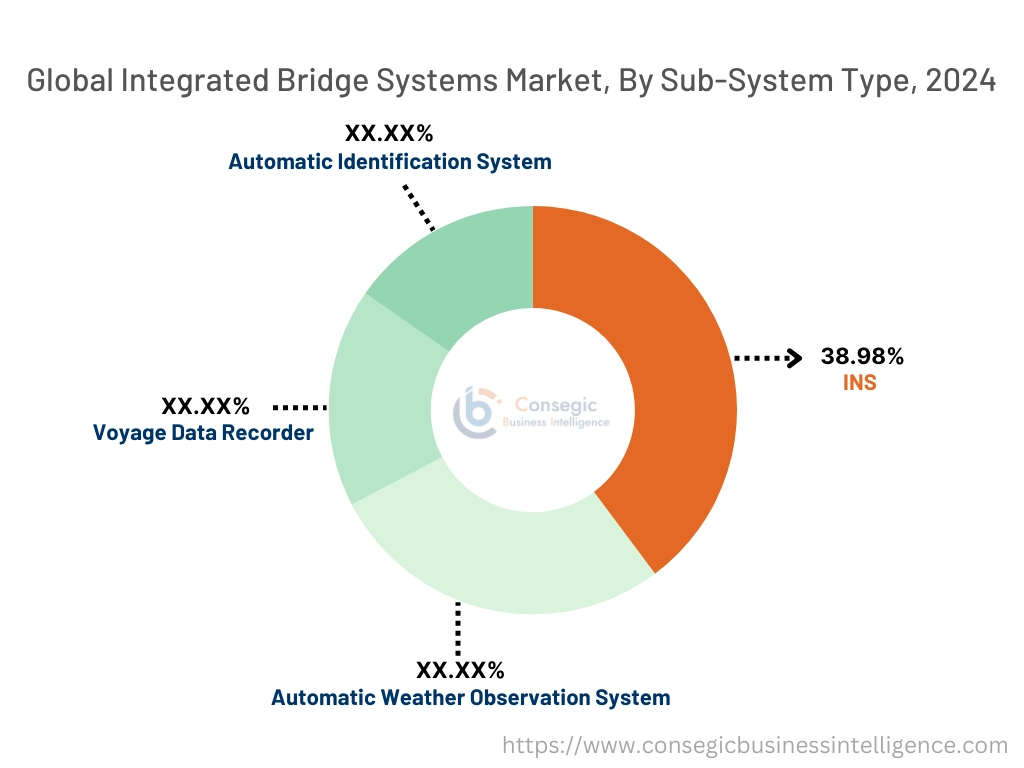
Regional Analysis:
The global integrated bridge systems market has been classified by region into North America, Europe, Asia-Pacific, MEA, and Latin America.
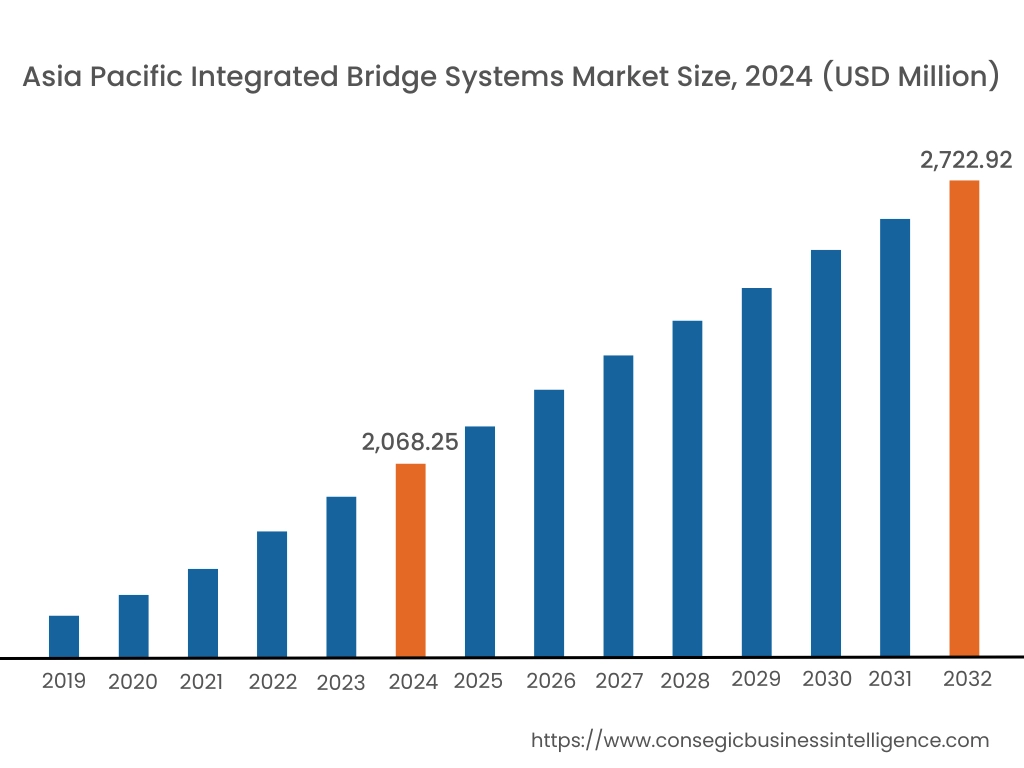
North America region was valued at USD 2,977.62 Million in 2024. Moreover, it is projected to grow by USD 3,021.30 Million in 2025 and reach over USD 3,826.72 Million by 2032. North America has stringent maritime safety regulations, driving the demand for advanced technology solutions to enhance vessel safety and operational efficiency. Additionally, the region boasts a strong defense sector with significant investments in naval modernization, driving demand for advanced solutions for military vessels, including frigates, destroyers, and submarines. Moreover, the region is at the forefront of autonomous shipping technology development. Integrated bridge systems play a crucial role in enabling autonomous vessel operations by providing integrated navigation, communication, and control systems.
- For instance, the Mayflower Autonomous Ship (MAS) project aims to develop and operate the world's first fully autonomous, unmanned research vessel. The project is led by marine research non-profit ProMare in collaboration with IBM as the lead technology partner, to improve autonomous marine technology.
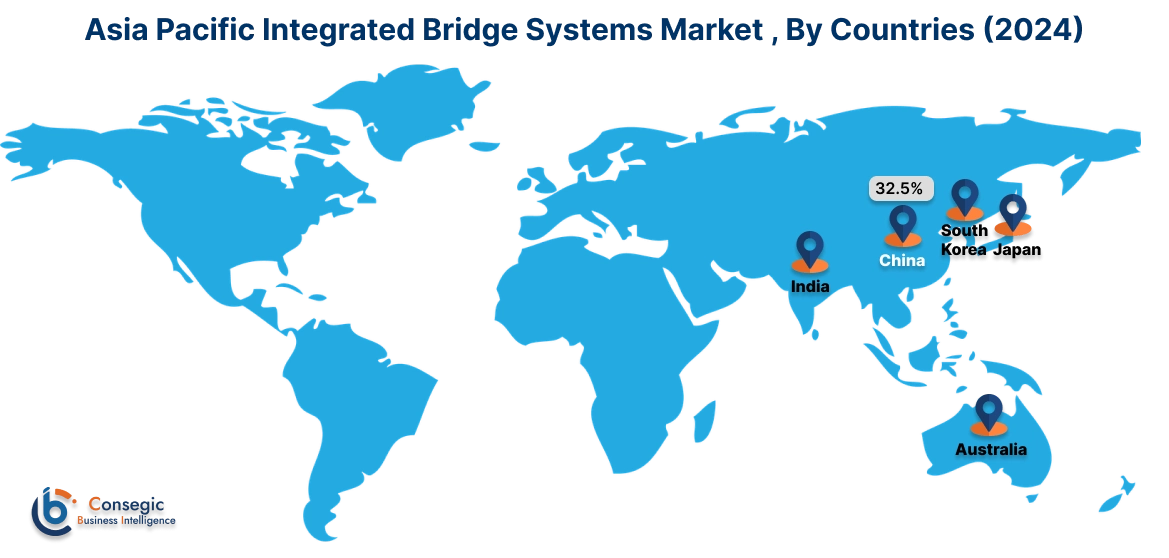
Asia Pacific region was valued at USD 2,068.25 Million in 2024. Moreover, it is projected to grow by USD 2,102.85 Million in 2025 and reach over USD 2,722.92 Million by 2032. Out of these, China accounted for the largest revenue share of 32.5% in 2024. The region boasts a massive volume of maritime trade, with countries like China, Japan, and South Korea being major players in global shipping. This high volume of maritime traffic necessitates the adoption of advanced navigation and communication systems to ensure safety and efficiency. Additionally, countries like China, South Korea, and Japan are major shipbuilding hubs, producing a large number of new vessels each year. These newly built vessels are often equipped with the latest technology, driving integrated bridge systems market demand.
- For instance, according to Department of Scientific and Industrial Research, the global shipbuilding industry is dominated by three East Asian giants: South Korea, China, and Japan. These nations collectively account for over 90% of new ship orders, with China leading the pack at 40% of global tonnage, followed by South Korea at 34%.
As per the integrated bridge systems market analysis, European countries is expected to witness steady growth in the market, driven by factors such as stringent safety regulations, a focus on environmental sustainability, and advancements in autonomous shipping technologies. Additionally, the market in Latin America is projected to exhibit moderate growth, driven by increasing maritime trade activities and the growing focus on improving safety standards in the region. Moreover, Middle East & Africa is anticipated to experience significant growth, driven by increasing investments in maritime infrastructure, growing offshore oil and gas activities, and the development of new shipping routes.
Top Key Players and Market Share Insights:
The market is highly competitive with major players providing integrated bridge systems solutions to the national and international markets. Key players are adopting several strategies in research and development (R&D), product innovation, and end-user launches to hold a strong position in the market. Key players in the integrated bridge systems industry include-
- Raytheon Technologies Corporation (US)
- Northrop Grumman Corporation (US)
- Wärtsilä Corporation (Finland)
- Alphatron Marine (Netherlands)
- Hensoldt (Germany)
- Kongsberg (Norway)
- Furuno Electric Co. Ltd. (Japan)
- Sperry Marine (UK)
- Simrad Yachting (Norway)
- Tokyo Keiki (Japan)
Recent Industry Developments :
Partnerships & Collaborations:
- In August 2024, Leonardo DRS has been awarded a USD 49 million contract to provide additional advanced Joint Assault Bridge systems to the U.S. Army and the Romanian military. The Joint Assault Bridge (JAB) is a next-generation track-wheeled armored engineer vehicle built on a modified M1A1 Abrams Main Battle Tank chassis. It is designed to deliver assault-bridging capabilities and provide freedom of maneuver to U.S and allied armored forces.
Integrated Bridge Systems Market Report Insights :
| Report Attributes | Report Details |
| Study Timeline | 2019-2032 |
| Market Size in 2032 | USD 10,603.26 Million |
| CAGR (2025-2032) | 3.4% |
| By Component |
|
| By Ship Type |
|
| By Sub-System Type |
|
| By Region |
|
| Key Players |
|
| North America | U.S. Canada Mexico |
| Europe | U.K. Germany France Spain Italy Russia Benelux Rest of Europe |
| APAC | China South Korea Japan India Australia ASEAN Rest of Asia-Pacific |
| Middle East and Africa | GCC Turkey South Africa Rest of MEA |
| LATAM | Brazil Argentina Chile Rest of LATAM |
| Report Coverage |
|
Key Questions Answered in the Report
How big is the Integrated Bridge Systems market? +
The Integrated Bridge Systems Market Size is estimated to reach over USD 10,603.26 Million by 2032 from a value of USD 8,212.49 Million in 2024 and is projected to grow by USD 8,336.17 Million in 2025, growing at a CAGR of 3.4% from 2025 to 2032.
What specific segmentation details are covered in the integrated bridge systems report? +
The integrated bridge systems report includes specific segmentation details for component, ship type, sub-system type and regions.
Which is the fastest segment anticipated to impact the market growth? +
In the integrated bridge systems market, the software is the fastest-growing segment during the forecast period.
Who are the major players in the Integrated Bridge Systems market? +
The key participants in the Integrated Bridge Systems market are Raytheon Technologies Corporation (US), Northrop Grumman Corporation (US), Wärtsilä Corporation (Finland), Kongsberg (Norway), Furuno Electric Co. Ltd. (Japan), Sperry Marine (UK), Simrad Yachting (Norway), Tokyo Keiki (Japan), Alphatron Marine (Netherlands), Hensoldt (Germany) and Others.
